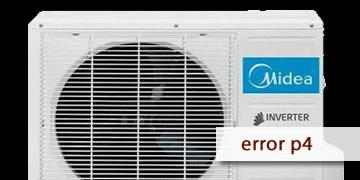Error P4 on Midea Air Conditioner
Table of Contents

A preventive warning you should pay attention to
The annoying P4 error code on your display can mean two different things depending on your unit model. On one hand, it might be warning about an electrical issue in Phase B, where the compressor is drawing more than 25 amps. On the other hand, in some models, it indicates that the compressor discharge temperature has exceeded 115°C. It’s as if your air conditioner is saying, “Either I’m getting too much current or I’m overheating.”
The good news is that in both cases, the system is smart: it will shut down automatically to protect itself and resume operation once everything returns to normal (either the voltage or temperature drops). However, if this happens 5 times within a 2-hour period, you’ll need to perform a manual reset. Let’s go over the possible causes of this issue:
- If your model relates to the Phase B current issue, the most common causes are dangerous voltage fluctuations in your home: Think of it like a surge that burns out your lightbulbs—only here, your air conditioner protects itself before damage occurs. It might also be due to a stressed compressor consuming more energy than normal.
- For models where P4 refers to overheating, the causes are usually more mechanical: A dirty condenser (that fin-covered grid on the outdoor unit) is the prime suspect because it prevents proper heat dissipation. It could also be due to low refrigerant levels, a malfunctioning outdoor fan, or even a faulty temperature sensor giving inaccurate readings.
How to fix error code P4 step by step on Midea air conditioners
Now it’s time to explain, step by step, how to fix this problem and get your air conditioner running again so you can say goodbye to the heat:
- First aid for your AC unit: Start by turning off the unit completely using the main switch or remote, and unplug it from the power outlet. Let it rest for at least 30 minutes to allow the electronic components to discharge and the compressor to cool down if it was overheating.
- Check the voltage reaching your air conditioner: Use a multimeter to measure the voltage at the outlet where the unit is connected. It should be between 210V and 230V (for 220V systems). If you detect very low or high voltages, the issue might be in your electrical installation, and you’ll need an electrician to inspect it thoroughly.
- Deep-clean the outdoor unit: With the power still off, remove the cover from the outdoor unit and carefully clean the condenser. Use a soft brush to remove the dust between the fins. You can use a hydrojet, but apply gentle pressure to avoid bending the condenser fins or coils.
- Check the outdoor fan: Make sure it spins freely with no blockages or obstructions. Briefly turn on the unit (just for a few seconds) and watch to see if the fan starts immediately and spins at full speed. A slow fan won’t release enough heat, causing the unit to overheat and triggering the temperature sensors.
- Inspect the electrical wiring: Visually check the power cables for damage, fraying, or signs of overheating. Pay close attention to where the wires connect to the outdoor unit, as these terminals can corrode or accumulate sulfates over time. Perform any necessary repairs and clean all terminal connections end to end.
- For repeated overheating issues: If the error keeps appearing and you suspect it’s due to high temperature, make sure the refrigerant pipes are not kinked or crushed. Also ensure the outdoor unit has enough clearance for airflow—at least 50 cm on all sides.
- If after these basic checks the P4 error persists, it’s time to call a professional: A certified technician can quickly diagnose the problem. They can accurately measure the compressor's current draw, verify the condition of the temperature sensors, identify complex faults in the control board, and test the pressure of the refrigeration system.
Remember, to keep your air conditioner running smoothly: schedule annual preventive maintenance before summer, install a voltage regulator if you experience frequent power fluctuations, keep both the indoor filters and outdoor unit clean, avoid overworking the unit during extreme heat, and consider installing awnings or blinds to reduce heat load indoors.